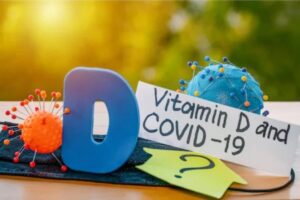More About Vitamin D and Covid-19
Now 22 months into a global pandemic, we’ve all learned a lot and we’ve come a long way in our ability to make it. We know now that getting vaccinated isn’t enough. We still must do everything we can to be healthy in case we experience a COVID-19 infection.
While no magic bullet exists, I still believe all of us need to do a few key things to maintain a healthy immune system for the day COVID comes calling.
Early during the pandemic, I wrote about the importance of vitamin D in preventing a severe COVID infection. Now almost two years in, research still points to vitamin D status as one of the most import factors in surviving a severe COVID-19 infection.
Recent Research

An overwhelming number of epidemiological associations exist between incidence and severity of COVID-19 and vitamin D deficiency/insufficiency. A metanalysis published in Frontiers in Nutrition in March examined 14 studies containing 999,179 participants on the associations between vitamin D status and severe COVID-19. The study found low vitamin D status was associated with a higher rate of severe COVID-19 and a higher mortality rate.
A study published last month by Purdue University and the National Institutes of Health revealed new insights into how vitamin D reduces inflammation caused by immune cells that play a role in the body’s response during severe COVID-19.
For your body to fight off a virus like SARS-CoV2, it must produce a pro-inflammatory response. But when this response goes unchecked, it can cause severe tissue damage, especially in the lungs.
The study demonstrated that vitamin D reduces inflammation caused by T cells. T cells, an important part of the immune system, develop from stem cells in bone marrow. They play a critical role in the immune response against COVID-19.
In normal infections, T cells go through a pro-inflammatory phase. The pro-inflammatory phase clears the infection, and then the system shuts down and goes into an anti-inflammatory phase. Vitamin D helps speed up the transition from pro-inflammatory to the anti-inflammatory phase of the T cells.
The Purdue University study confirmed that vitamin D prevents the immune system from going into overdrive in the lungs. This prevents severe damage in the lungs seen in so many COVID-19 cases. The study could give rise to the use of intravenous vitamin D as a treatment for the most severe COVID-19 cases.
In May 2020, Northwestern University published an article claiming that vitamin D levels might play a role in COVID-19 mortality rates. The study analyzed patient data from 10 countries. The team found a correlation between low vitamin D levels and hyperactive immune systems. Vitamin D strengthens innate immunity and prevents overactive immune responses.
The researchers looked at data from hospitals and clinics across China, France, Germany, Italy, Iran, South Korea, Spain, Switzerland, the United Kingdom, and the United States. They found that patients from countries with high COVID-19 mortality rates possessed lower levels of vitamin D compared to patients in countries that were not as severely affected.

Understanding Status
Twenty-two months into the pandemic, we understand that maintaining a healthy vitamin D status could save your life.
The only real way to tell if you are getting enough vitamin D is to have your physician test the level of 25-hydroxyvitamin D in your blood. Ideal levels of vitamin D are between 40 and 80 ng/ml.
According to the National Health and Nutrition Examination Survey, approximately 70% of adults in the US are Vitamin D insufficient. This means their blood serum levels contain less than 30 ng/ml of Vitamin D. This also indicates an increased risk for colds and cough, infection, fatigue, mood swings, weak bones, and achy joints.
Vitamin D deficiency is defined as blood levels of vitamin D below 20 ng/ml. At this level, parathyroid hormone levels, which control your body’s calcium levels, start to rise outside of healthy ranges. This also means rickets and osteoporosis are right around the corner. Approximately 28.9% of US adults have deficient Vitamin D levels.
Problems for Certain Populations
Vitamin D deficiency tends to concentrate in certain segments of our population. The elderly are most affected, because the skin’s efficiency to produce vitamin D declines with age. A 70-year-old may produce four times less vitamin D than their former 20-year-old selves.
People with obesity also exhibit a high prevalence of Vitamin D deficiency because fat-soluble vitamin D has greater difficulty releasing into their bloodstream. Obese individuals have greater than 50% less bioavailability of vitamin D than non-obese individuals. The CDC recently reported that 48% of people hospitalized for COVID-19 are obese.
Vitamin D deficiency also emerges more often in people living in northern latitudes, where less UVB radiation reaching the atmosphere means less of it reaching the skin to facilitate the production of vitamin D. Having dark-colored skin also impairs vitamin D production. According to the CDC, 33 percent of people hospitalized for COVID-19 were African Americans who only constitute 13 percent of the US population, suggesting that African Americans may be at a much higher risk for severe COVID-19.
Getting Enough Vitamin D
You get small amounts of vitamin D from your food. However, your primary source of Vitamin D is a process that starts in your skin following exposure to UVB light from the sun and continues in your liver and kidneys, where vitamin D’s active form is made.
Most people get enough vitamin D from being out in the sun for 15 to 30 minutes with their forearms, hands or lower legs uncovered and without sunscreen from late March to the end of September, especially from 11am to 3pm. People with darker skin may require as much as 120 minutes in the sun. And of course, the more skin you expose, the more vitamin D your body can produce. Since vitamin D is fat soluble, your body can store it for a rainy day (pun intended).
Vitamin D Supplementation
Since most of us don’t get enough vitamin D from sun during the winter months, it’s important to consider vitamin D supplementation. We do get vitamin D from foods like salmon, trout, and vitamin D fortified milk, but usually not enough.
 The nutrition board of the Institute of Medicine conservatively set the tolerable upper intake of vitamin D at a level of around 4,000 IU/day. The board considers this level of supplementation safe for pregnant and lactating women, suggesting that, at that dose, toxicity is extremely unlikely. Research has shown the 4,000 IU/day level of supplementation eliminates deficiencies in African American men.
The nutrition board of the Institute of Medicine conservatively set the tolerable upper intake of vitamin D at a level of around 4,000 IU/day. The board considers this level of supplementation safe for pregnant and lactating women, suggesting that, at that dose, toxicity is extremely unlikely. Research has shown the 4,000 IU/day level of supplementation eliminates deficiencies in African American men.
A blood test is the best way to determine how much vitamin D you need to supplement with. If your vitamin D levels are below 40 ng/ml, you can use appropriate supplementation levels to achieve a healthy range of 40 to 80 ng/ml. Approximately 1000 IU of vitamin D increases blood levels of 25-hydroxyvitamin D by around 5 ng/ml.
I personally take 2,000 IU of Naturewise Vitamin D during the winter months. I drink a good amount of whole milk and eat salmon once a week, so I know I’m getting some vitamin D from my food.
You should know that taking too much vitamin D can be toxic, so if you decide to supplement, stay at or below 4,000 IU/day.
If you want to splurge, the best brand of vitamin D, without a doubt, is Carlson.
Stay Strong and Healthy
Bo Railey

